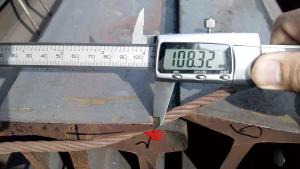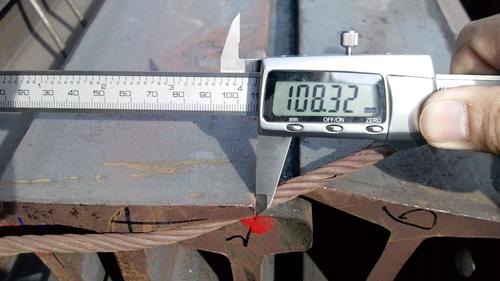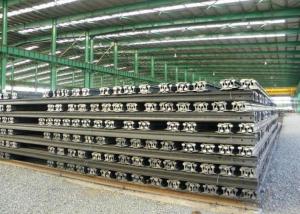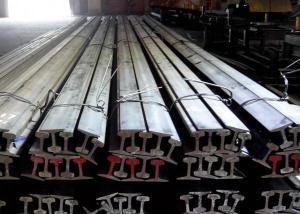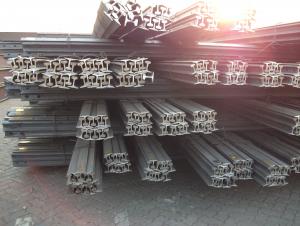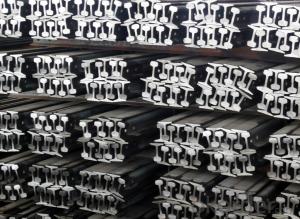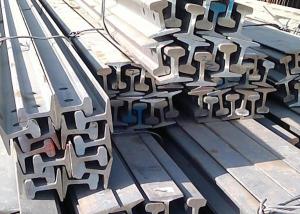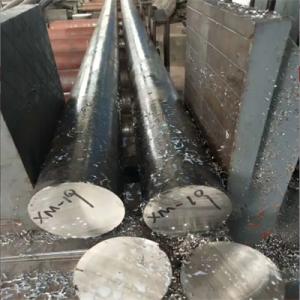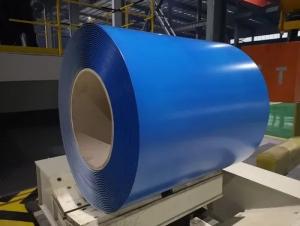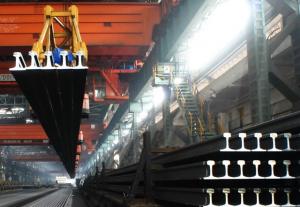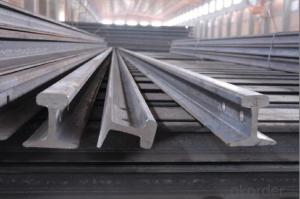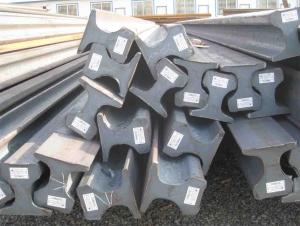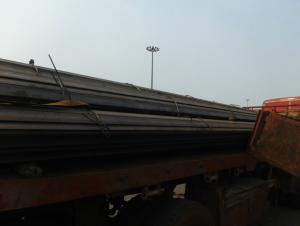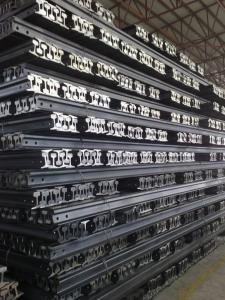Rivo Sport Steel Rails 155mm - High Quality Light Steel Rail Q235, 55Q for Construction
- Loading Port:
- China main port
- Payment Terms:
- TT or LC
- Min Order Qty:
- 25 m.t.
- Supply Capability:
- 100000 m.t./month
OKorder Service Pledge
OKorder Financial Service
You Might Also Like
Product Description of Light Steel Rail Q235, 55Q with High Quality for Construction:
Sizes: 38kg, 43kg, 45kg, 50kg, 60kg.
Production Standard: GB2585-81, DIN, AREMA, JIS, BS, UIC, etc.
Material: 50MN, U71MN, 900A, 110A, etc.
Length: 6m-25m according to the requriements of the clients
Usages of Light Steel Rail Q235, 55Q with High Quality for Construction:
Light rail is mainly used in forest region, mines, factories and construction sites laid of the place such as temporary transport line and light motorcycles with line. Be widely used for railway, subway, transportation track, express, curve way, tunnel way and so on.
Packaging & Delivery of Light Steel Rail Q235, 55Q with High Quality for Construction:
1. Packing: it is nude packed in bundles by steel wire rod
2. Bundle weight: not more than 3.5MT for bulk vessel; less than 3 MT for container load
3. Marks:
Color marking: There will be color marking on both end of the bundle for the cargo delivered by bulk vessel. That makes it easily to distinguish at the destination port.
Tag mark: there will be tag mark tied up on the bundles. The information usually including supplier logo and name, product name, made in China, shipping marks and other information request by the customer.
If loading by container the marking is not needed, but we will prepare it as customer request.
4. Transportation: the goods are delivered by truck from mill to loading port, the maximum quantity can be loaded is around 40MTs by each truck. If the order quantity cannot reach the full truck loaded, the transportation cost per ton will be little higher than full load.
5. Delivered by container or bulk vessel
6. Delivery Time: All the Hot Rolled Steel Rail will be transpoted at the port of Tianjin, China within 30 days after receiving the advance payment by T/T or the orginal L/C at sight.
Inspection of Light Steel Rail Q235, 55Q with High Quality for Construction:
We will send the MTC of the factory to the clients dirrectly which contain the anlisis of the heat, chemiqul composition, phisical characteristicas, etc.
And our inspectors will arrive at the factory to meke the inspection of the size, length, weight and quantity before the transportation from the factory.
FAQ:
Q1: How soon can we receive the product after purchase?
A1: Within three days of placing an order, we will begin production. The specific shipping date is dependent upon international and government factors, but is typically 7 to 10 workdays.
Q2: How do we guarantee the quality of our products?
A2: We have established an advanced quality management system which conducts strict quality tests at every step, from raw materials to the final product. At the same time, we provide extensive follow-up service assurances as required.
Q3: Why buy Materials & Equipment from OKorder.com?
A3: All products offered by OKorder.com are carefully selected from China's most reliable manufacturing enterprises. Through its ISO certifications, OKorder.com adheres to the highest standards and a commitment to supply chain safety and customer satisfaction.
Images:


- Q:Can steel rails be used in mountainous regions?
- Indeed, mountainous regions can make effective use of steel rails. Renowned for their robustness and endurance, steel rails are well-suited for a wide range of terrains, including mountainous areas. They possess the capacity to withstand the immense weight and strain exerted by trains, as well as endure the harsh conditions typically encountered in such landscapes. Furthermore, steel rails exhibit exceptional tensile strength and can resist deformation, thereby guaranteeing the stability and security of train tracks in these demanding environments. Ultimately, steel rails are an exceedingly dependable option for railway systems operating within mountainous regions.
- Q:How do steel rails contribute to reducing the risk of rail squats and shelling?
- Steel rails contribute to reducing the risk of rail squats and shelling through their superior strength and durability. The high tensile strength of steel allows the rails to withstand heavy loads and constant train traffic without deforming or developing cracks. This prevents the formation of rail squats, which are localized plastic deformations that can lead to rail failure. Additionally, the hardness and wear resistance of steel rails make them less prone to shelling, a phenomenon where the rail surface deteriorates due to repeated wheel-rail contact. By maintaining their structural integrity, steel rails minimize the risk of rail squats and shelling, ensuring safer and more reliable railroad operations.
- Q:How are steel rails protected from theft and vandalism?
- Steel rails are protected from theft and vandalism through various measures that aim to deter potential perpetrators and ensure the security of these essential infrastructures. One of the primary methods employed is the use of security systems and surveillance technology. Many railway companies install closed-circuit television (CCTV) cameras along the tracks to monitor any suspicious activities. These cameras are often equipped with motion sensors and can transmit live feeds to security personnel who can respond swiftly in case of a breach. In addition to surveillance, railway companies also employ physical barriers and fencing to restrict unauthorized access to the rail tracks. Perimeter fences, barriers, and gates are often installed to deter thieves and vandals from approaching the rails. These physical deterrents are designed to make it more challenging for individuals to remove or tamper with the steel rails. Furthermore, some railway companies have implemented advanced security measures such as the use of GPS tracking systems and sensors embedded within the rails themselves. These systems can detect any unauthorized tampering or movement of the rails, immediately alerting authorities to the potential theft or vandalism. Collaboration with law enforcement agencies is another crucial aspect of protecting steel rails. Railway companies often work closely with local police departments and railway security forces to ensure regular patrols and timely response to any security threats. This collaboration helps in deterring potential criminals and ensures a swift response when incidents occur. Lastly, public awareness campaigns are often conducted to educate the public about the importance of rail security and the consequences of theft or vandalism. This helps in creating a sense of collective responsibility and encourages individuals to report any suspicious activities they may witness near the tracks. Overall, the protection of steel rails from theft and vandalism is a multi-faceted approach that combines surveillance technology, physical barriers, advanced security systems, collaboration with law enforcement, and public awareness. These measures collectively work to deter potential criminals and ensure the safety and integrity of rail infrastructure.
- Q:What are the benefits of using steel rails in high-speed train systems?
- There are several benefits of using steel rails in high-speed train systems. Firstly, steel rails offer excellent durability and strength, allowing them to withstand the heavy loads and high speeds of the trains. This reduces the need for frequent maintenance and replacement, resulting in lower operational costs. Secondly, steel rails provide a smooth and stable surface for the trains to travel on, ensuring a comfortable ride for passengers and minimizing the risk of accidents or derailments. Additionally, steel rails have high resistance to wear and tear, reducing the friction between the wheels and the tracks, which in turn increases energy efficiency and decreases fuel consumption. Overall, the use of steel rails in high-speed train systems enhances safety, efficiency, and cost-effectiveness.
- Q:Can steel rails be used in bridges and viaducts?
- Yes, steel rails can be used in bridges and viaducts. Steel rails are commonly used as structural elements in bridge and viaduct construction due to their high strength, durability, and resistance to corrosion. They provide support and stability to the structure, allowing for the smooth movement of trains and other vehicles over long spans.
- Q:How are steel rails affected by ground settlement or shifting?
- Ground settlement or shifting has a significant impact on steel rails. The sinking or collapsing of the ground beneath the rails, known as ground settlement, and the lateral movement of the ground, referred to as ground shifting, both pose risks to the stability and integrity of the rails. When ground settlement occurs, it results in an uneven level beneath the rails. This unevenness creates stress concentrations on the rails, leading to increased wear and tear. Misalignment of the rails can also occur, causing a rough and bumpy ride for trains. Furthermore, settlement can create voids or depressions beneath the rails, further compromising their stability. On the other hand, ground shifting causes lateral movement beneath the steel rails. This movement can lead to rail misalignment and increase the risk of derailment. The lateral forces exerted by shifting ground can also cause the rails to buckle, resulting in significant damage and disruption to the railway system. To mitigate the impact of ground settlement or shifting on steel rails, various measures can be implemented. Regular monitoring of ground conditions is crucial, as is the implementation of proper drainage systems to prevent water accumulation. Stabilizing the ground using techniques such as soil reinforcement or ground improvement methods is also important. Additionally, proper maintenance and inspection of the rails are essential to detect any signs of settlement or shifting early on and take appropriate corrective actions. In conclusion, ground settlement or shifting has detrimental effects on steel rails. It is imperative to promptly monitor and address these issues to ensure the safety and efficiency of railway systems.
- Q:Are steel rails used in military applications?
- Yes, steel rails are used in military applications. They are commonly used for the construction of railway tracks for military transportation purposes, including the movement of troops, equipment, and supplies.
- Q:How do steel rails contribute to train braking performance?
- Steel rails contribute to train braking performance in several ways. Firstly, steel rails provide a smooth and stable surface for the train wheels to grip onto during braking, allowing for effective traction and preventing wheel slippage. This ensures that the train can decelerate efficiently and come to a stop in a shorter distance. Additionally, the hardness and durability of steel rails allow for consistent and reliable braking performance over long periods of time, minimizing maintenance needs. Overall, steel rails play a crucial role in maximizing the braking efficiency and safety of trains.
- Q:Can steel rails be used in railway signaling systems?
- Railway signaling systems utilize steel rails to ensure safe and efficient train operations. These systems rely on various signaling devices, including signals, switches, and track circuits, which are strategically placed along the railway tracks and interconnected to form a network. Steel rails are essential in railway signaling systems due to their durability, strength, and ability to withstand heavy loads and wear. They provide a stable and secure foundation for the signaling devices mounted on them, guaranteeing the integrity of the system. Moreover, steel rails possess excellent electrical conductivity, which is crucial for certain signaling devices to function properly. For instance, track circuits rely on the rails' electrical continuity to detect the presence of trains and relay accurate information to the signaling system. The conductivity of steel rails allows for efficient transmission of electrical signals, ensuring reliable train detection and signaling. In conclusion, steel rails play a vital role in railway signaling systems by providing a robust foundation for signaling devices and enabling safe and efficient train operations. Their durability, strength, and electrical conductivity make them an optimal choice for these systems.
- Q:What are the dimensions of the base of steel rails?
- The dimensions of the base of steel rails can vary depending on the specific type and design. However, common dimensions for the base of steel rails typically range from 4 inches to 7 inches in width and 6 inches to 9 inches in height.
1. Manufacturer Overview |
|
|---|---|
| Location | |
| Year Established | |
| Annual Output Value | |
| Main Markets | |
| Company Certifications | |
2. Manufacturer Certificates |
|
|---|---|
| a) Certification Name | |
| Range | |
| Reference | |
| Validity Period | |
3. Manufacturer Capability |
|
|---|---|
| a)Trade Capacity | |
| Nearest Port | |
| Export Percentage | |
| No.of Employees in Trade Department | |
| Language Spoken: | |
| b)Factory Information | |
| Factory Size: | |
| No. of Production Lines | |
| Contract Manufacturing | |
| Product Price Range | |
Send your message to us
Rivo Sport Steel Rails 155mm - High Quality Light Steel Rail Q235, 55Q for Construction
- Loading Port:
- China main port
- Payment Terms:
- TT or LC
- Min Order Qty:
- 25 m.t.
- Supply Capability:
- 100000 m.t./month
OKorder Service Pledge
OKorder Financial Service
Similar products
New products
Hot products
Hot Searches
Related keywords
